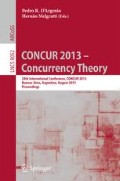Abstract
We introduce a notion of subsumption for domains used in abstract interpretation. We show that subsumption has the same properties and applications in the context of abstract interpretation that simulation has for transition systems. These include a modal characterisation theorem, a fixed point characterisation, and the construction of property-preserving abstractions. We use the notion of conjugate functions from algebraic logic to develop bisubsumption, an order-theoretic generalisation of bisimulation to Boolean domains. We prove a representation theorem that relates simulation and subsumption.
Access this chapter
Tax calculation will be finalised at checkout
Purchases are for personal use only
Preview
Unable to display preview. Download preview PDF.
References
Abdulla, P.A., Chen, Y.-F., Holík, L., Mayr, R., Vojnar, T.: When simulation meets antichains: on checking language inclusion of nondeterministic finite (tree) automata. In: Proc. of Tools and Algorithms for the Construction and Analysis of Systems, pp. 158–174 (2010)
Abdulla, P.A., Čerāns, K., Jonsson, B., Tsay, Y.-K.: Algorithmic analysis of programs with well quasi-ordered domains. Information and Computation 160(1-2), 109–127 (2000)
Celani, S.A., Jansana, R.: Priestley duality, a Sahlqvist theorem and a Goldblatt-Thomason theorem for positive modal logic. Logic Journal of the IGPL 7(6), 683–715 (1999)
Cîrstea, C.: A modular approach to defining and characterising notions of simulation. Information and Computation 204(4), 469–502 (2006)
Cousot, P., Cousot, R.: Systematic design of program analysis frameworks. In: Proc. of Principles of Programming Languages, pp. 269–282. ACM Press (1979)
Cousot, P., Cousot, R.: Temporal abstract interpretation. In: Proc. of Principles of Programming Languages, pp. 12–25. ACM Press (2000)
Doyen, L., Raskin, J.-F.: Antichain algorithms for finite automata. In: Proc. of Tools and Algorithms for the Construction and Analysis of Systems (2010)
Finkel, A., Schnoebelen, P.: Well-structured transition systems everywhere! Theoretical Computer Science 256(1-2), 63–92 (2001)
Gehrke, M., Nagahashi, H., Venema, Y.: A Sahlqvist theorem for distributive modal logic. Annals of Pure and Applied Logic 131(1-3), 65–102 (2005)
van Glabbeek, R.J.: The linear time - branching time spectrum II. In: Best, E. (ed.) CONCUR 1993. LNCS, vol. 715, pp. 66–81. Springer, Heidelberg (1993)
Henzinger, T.A., Majumdar, R., Raskin, J.-F.: A classification of symbolic transition systems. ACM Transactions on Computational Logic 6(1), 1–32 (2005)
Hughes, J., Jacobs, B.: Simulations in coalgebra. Theoretical Computer Science 327(1-2), 71–108 (2004)
Jónsson, B., Tarski, A.: Boolean algebras with operators. American Journal of Mathematics 74(1), 127–162 (1952)
Levy, P.B.: Similarity quotients as final coalgebras. In: Hofmann, M. (ed.) FOSSACS 2011. LNCS, vol. 6604, pp. 27–41. Springer, Heidelberg (2011)
Loiseaux, C., Graf, S., Sifakis, J., Bouajjani, A., Bensalem, S.: Property preserving abstractions for the verification of concurrent systems. Formal Methods in Systems Design 6(1), 11–44 (1995)
Lynch, N., Vaandrager, F.: Forward and backward simulations I: untimed systems. Information and Computation 121(2), 214–233 (1995)
Maidl, M.: The common fragment of CTL and LTL. In: Foundations of Computer Science, p. 643. IEEE Computer Society, Washington, DC (2000)
Malacaria, P.: Studying equivalences of transition systems with algebraic tools. Theoretical Computer Science 139(1-2), 187–205 (1995)
Ranzato, F., Tapparo, F.: Generalized strong preservation by abstract interpretation. J. of Logic and Computation 17(1), 157–197 (2007)
Sangiorgi, D.: On the origins of bisimulation and coinduction. ACM Transactions on Programming Languages and Systems 31(4), 15:1–15:41 (2009)
van Glabbeek, R.J.: The linear time – branching time spectrum I. the semantics of concrete, sequential processes. In: Handbook of Process Algebra, pp. 3–99. Elsevier (2001)
Author information
Authors and Affiliations
Editor information
Editors and Affiliations
Rights and permissions
Copyright information
© 2013 Springer-Verlag Berlin Heidelberg
About this paper
Cite this paper
D’Silva, V. (2013). Generalizing Simulation to Abstract Domains. In: D’Argenio, P.R., Melgratti, H. (eds) CONCUR 2013 – Concurrency Theory. CONCUR 2013. Lecture Notes in Computer Science, vol 8052. Springer, Berlin, Heidelberg. https://doi.org/10.1007/978-3-642-40184-8_34
Download citation
DOI: https://doi.org/10.1007/978-3-642-40184-8_34
Publisher Name: Springer, Berlin, Heidelberg
Print ISBN: 978-3-642-40183-1
Online ISBN: 978-3-642-40184-8
eBook Packages: Computer ScienceComputer Science (R0)

